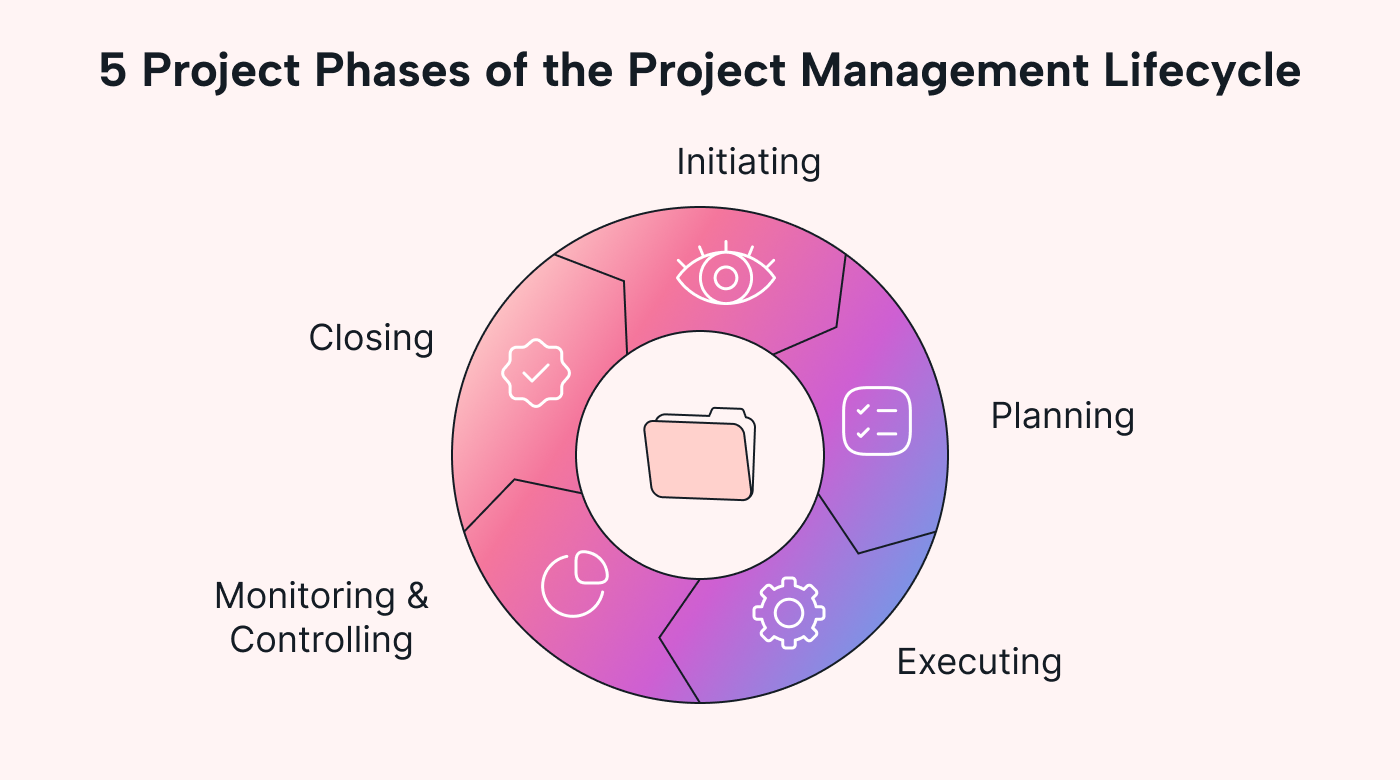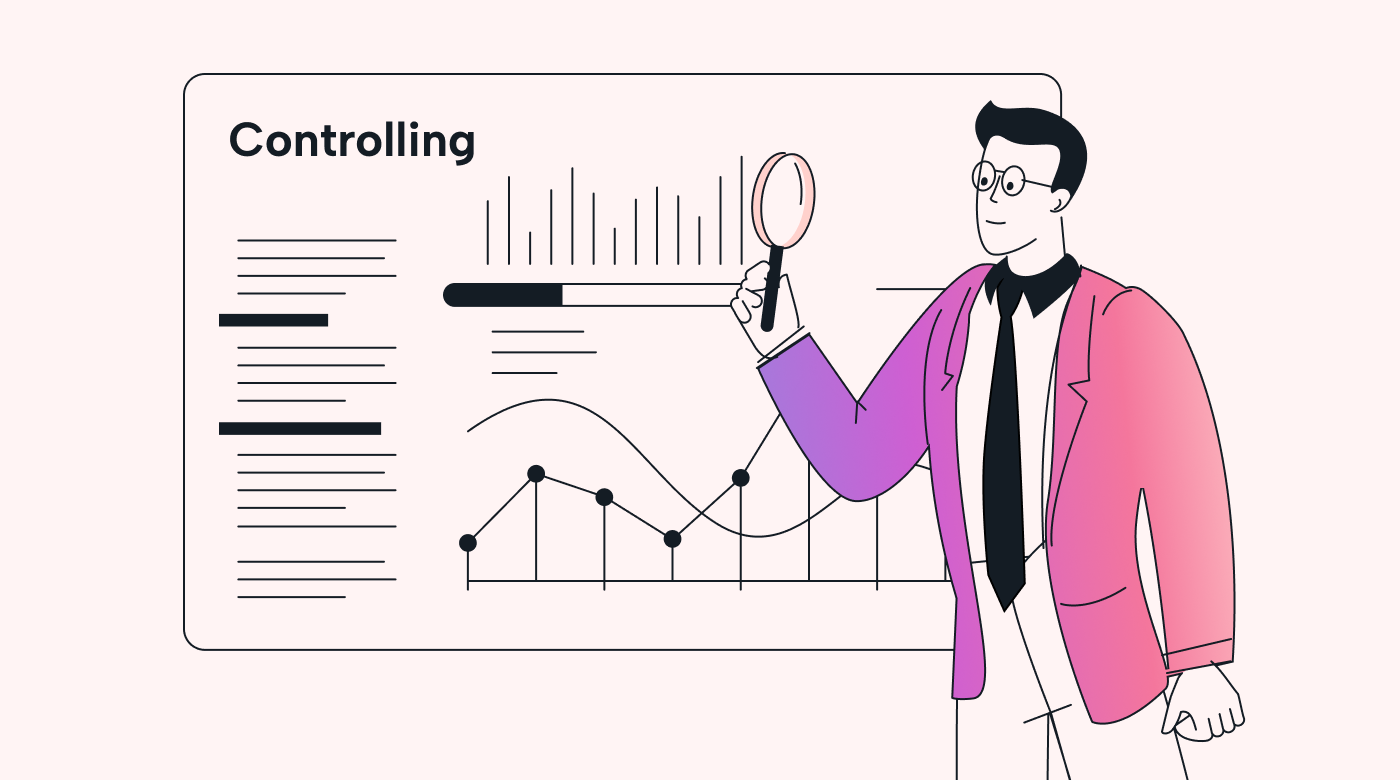Are you looking to optimize how you manage projects in your business?
You might think that with so much project management software available, understanding the core principles of project management isn’t necessary. This is categorically untrue. Project management tools rely heavily on accurate input to effectively manage and report on projects.
Whether you are looking to start a new project or are trying to improve your existing project processes, understanding the five phases of the project management lifecycle is key.
In this article, we’ll explore each phase in-depth – from initiation to closure – so that you can develop a better understanding of how successful projects are created and managed.
Let’s get started!
What are project phases?
The Project Management Institute (PMI) created the five-phase project management model, detailed in the Project Management Body of Knowledge (PMBOK) 7th edition.
In the five-phase model, projects are divided into five stages or groups. Regardless of size or complexity, every project goes through these phases. The project lifecycle begins with the initiation of a project and ends with the closure of the project.
 |
Each phase has its own objectives, deliverables, processes, and milestones. The five-phase model enables a project team to align on progress and expectations, improving organization, control, and results.
Why is the project management lifecycle still important in 2023?
Even in the age of AI-driven project management software, the project management lifecycle remains crucial. To efficiently manage projects, you need a structured approach that you can apply to any project, no matter how complex.
Here are just a few ways that the project management lifecycle is still relevant in 2023:
Adaptability
The project management lifecycle provides a structured framework from the first idea of a project to delivery. It allows you to adapt to changing circumstances or roadblocks as things change by creating space for contingency planning. This is especially important in 2023, where technology evolves rapidly, and market conditions can turn on a dime.
Goal alignment
The lifecycle also helps you align project goals with business objectives. For example, you can prioritize projects that contribute the most value to your strategic goals. And you can evaluate the progress of projects against objectives and make informed decisions about resource planning and budget allocation.
 |
Stakeholder engagement and communication
In an on-demand business environment, customers expect speedy delivery and transparent communication. The project phases involve stakeholders in planning, encourage creating communications, and prioritize collaboration.
Quality assurance (QA)
The project phases also incorporate quality assurance processes, such as testing, verification, and validation, to ensure you meet customer expectations and internal standards.
Knowledge transfer
The lifecycle encourages documentation and knowledge transfer at each phase. This enables you to learn from past projects and optimize for future projects. This is vital for continuous improvement and innovation.
The 5 project phases in detail (with examples)
Let’s take a look at these phases in more detail.
1. Initiating
The initiating phase marks the beginning of the project. It involves evaluating the project’s purpose and main objectives. The goal of this phase is to determine the feasibility of a project by defining the project scope.
 |
This phase ensures that the project is well-defined and has the support and resources required to be successfully delivered.
Key activities the initiating phase include:
- Forming the project team, including roles such as copywriter, graphic designer, and website developers.
- Setting the foundation for the project by determining the project’s purpose, which in our example is to deliver a website.
- Considering the stakeholders: Who’ll be involved in this project?
Artifacts produced include:
- A budget that outlines project costs and profit margins.
- A project charter: a formal document that establishes the project’s existence and provides the written authority to begin work.
- A feasibility study: to identify the problem the project aims to solve. It also outlines how it will address these issues.
- A statement of work (SoW): This is a crucial document for agencies, such as those who deliver website projects. It defines the project scope in detail, including all milestones achieved in delivering the project.
Phase one example: Starting a website project
Before work begins, the team must be defined. In this case, we’ll need a copywriter, a graphic designer, and web developers.
Next, we define what the project is: to build a website.
Why? Establish a client’s online presence and increase their conversions by 15%.
A budget is determined: How much will the client need to pay? How much will your business need to receive to produce the website, covering all costs and factoring in profit margins?
Then, outline all of the stages of work in a SoW draft that’ll receive further detail in the next stage.
2. Planning
The planning phase is the second phase of the project. It involves creating detailed plans to guide the project’s execution. This phase sets the pace and expectations for delivering the project. It also manages client expectations around communication and changes.
 |
Key activities in the planning phase include:
- Defining goals, objectives, and milestones that the project aims to achieve.
- Resource planning: determining the necessary personnel, equipment, and materials required to complete the project.
- Developing a risk management plan to identify potential risks and create contingency plans in the case of roadblocks in project execution.
- Setting key performance indicators (KPIs) to measure success. You’ll also use these to evaluate how well your project went when you reach the later phases: controlling and closing.
Artifacts produced
- A risk management plan: This document outlines any risks that could arise during the project execution with their corresponding contingency plans.
- A project schedule: This is a comprehensive timeline of project activities, often represented through a PERT chart to visually map out dependencies and timelines.
- A communication plan: Define how often, where, and when you and your client will communicate with each other.
- The project plan: This integrates all planning elements into a comprehensive plan for project completion. The details of this plan are added to the SoW for your client to sign, approving what will be delivered, by who, and when.
- You’ll also define what is success with a testing plan, including acceptance criteria.
Phase two example: Planning a website project
In the planning phase, your risk management plan aims to overcome roadblocks. These could be things such as how the design will be impacted if the copywriters can’t deliver on time. You can ask yourself questions like, ‘How will change be managed if a client requests multiple change rounds? Or wants to add more pages to the website?’
This is where creating a communication plan is extremely important. Your communication plan will formalize how you'll communicate with your client, and how changes will be managed.
Remember, you want to have everything documented.
Consider how you want changes to be requested by the client. In writing? Via email? Or through a formal process inside your project management software?
Who in your business will approve these changes? How will changes alter the budget and timeline? How will this be communicated to the client?
Make sure you also document your overall project timeline using a PERT chart to track all task dependencies and calculate your project timeline correctly. This way, when changes do arise, you can show the client (visually) how this change will alter the project timeline.
Then, flesh out your SoW and have the client sign and approve it. This document forms the legally binding contract between you and the client. Make sure you have every task accounted for with accurate timelines. Include your change process as well.
Be sure to include a document that outlines how success will be determined and how the project will be closed. This will be important when the project has been delivered.
3. Executing
In this phase, project activities are executed according to the project plan. Collaboration and coordination among team members and stakeholders is key to this phase.
 |
Key activities in the executing phase include:
- Coordinating resources, managing stakeholders, and implementing project deliverables.
- Project team members perform their assigned tasks and work toward achieving project objectives.
- Progress is tracked and checked to ensure that activities are delivered on schedule.
- Changes that require change management may arise, which has been accounted for in the planning phase.
- Quality control measures are executed to ensure project deliverables meet the defined standards.
- Risks are managed continuously, and contingencies are executed as needed.
- Progress is regularly reported on and documented for transparency.
Artifacts produced
- Status reports are provided to stakeholders.
- Document change requests are received, processed, approved, and implemented.
Phase three example: Executing a website project
It’s time to get to work. In this phase, you’ll execute your project plan. This stage is about monitoring the project as your team does their work. Are tasks being delivered on time? Are task statuses being kept up to date?
4. Controlling
In this fourth phase, project progress is tracked, and corrective actions are taken to keep the project on track.
 |
Key activities in the controlling phase include:
- Tracking project performance, comparing it to the project plan, and identifying deviations.
- Measuring project KPIs to assess progress and measure success.
- Keeping project stakeholders informed through regular progress reports and approved communication channels.
- Processing change requests and evaluating their impact on the project’s scope, schedule, and budget.
In this phase, while the work is progressing, you are looking to maintain control, and minimize deviations. This includes ongoing risk management, quality assurance, and resource management.
Artifacts produced
- Status reports are provided to stakeholders.
- Document change requests are initiated, processed, approved, and implemented.
Phase four example: Controlling a website project
As work on the website progresses, milestones are ticked off, and status updates are provided. If clients request changes, you’ll want to make sure to follow the formal change process (and document all changes).
You’ll also produce regular status reports to keep stakeholders informed. Stick to your agreed communication plan. Track work completion against the KPIs until the finished website is delivered.
5. Closing
In the fifth and final phase, the project is formally completed. All project activities are ticked off and the project is transitioned to (and signed off by) the client.
 |
Key activities in the closing phase include:
- Finalizing and documenting project deliverables.
- Obtaining formal acknowledgment from stakeholders.
- Evaluating project performance and measuring it against project objectives and success criteria.
- Capturing and documenting lessons learned to improve future projects.
- Releasing project resources and closing contracts.
- Celebrating team success and acknowledging team contributions.
Artifacts produced
- Formal acknowledgment from stakeholders is obtained in a completed signoff document.
- Final project reports, including financial summaries, are prepared.
- Stakeholder feedback and satisfaction surveys may be conducted to assess project impact.
- Your marketing team might also gather testimonials and reviews.
Phase five example: Delivering a website project
Your website has been delivered. The team is happy with the outcome, and the client has agreed that the website is ready. It’s time to document all of this by getting contracts closed, formal acknowledgments signed, and client satisfaction documented in a post-delivery survey.
The five phases and Agile project management
The five phases of the project management lifecycle have long been associated with the waterfall methodology, but how are they leveraged by Agile teams?
Agile also has five phases, named differently but similar in intent. The Agile Project Management (APM) framework phases correlate as follows:
- Envision: Corresponds with the initiation phase of waterfall. In this phase, define the project objectives and purpose.
- Speculate: Similar to the planning phase, you will create a list of all project features in the speculate phase.
- Explore: Corresponds with the execution phase, where you’ll explore all possible avenues to complete the work best.
- Adapt: Aligns with the control phase but differs in actively seeking ongoing client feedback throughout the execution process rather than acting to prevent client interventions.
- Close: Similar to the close phase from waterfall. The project is wrapped up and signed off.
Master the project phases with Motion
As we’ve explored, effective project management includes five phases, whether you use the waterfall, Agile, or a hybrid method.
Smart project management software supports the project phases by providing valuable insights into task progress, status reporting during project execution, and performance evaluation..
So, what comes next?
Streamline your project tracking with automated project management.
An automated project management tool like Motion can give you a real-time overview of the status of your tasks, keeping you and your team on track.
Visual tracking in Motion will make your five phases (initiation, planning, executing, controlling, and closing) much easier to implement.
Reduce your manual planning and tracking time by using your Motion Intelligent Calendar to assign tasks to your team and auto-tracks task statuses.
Grab your 7-day free trial today.





